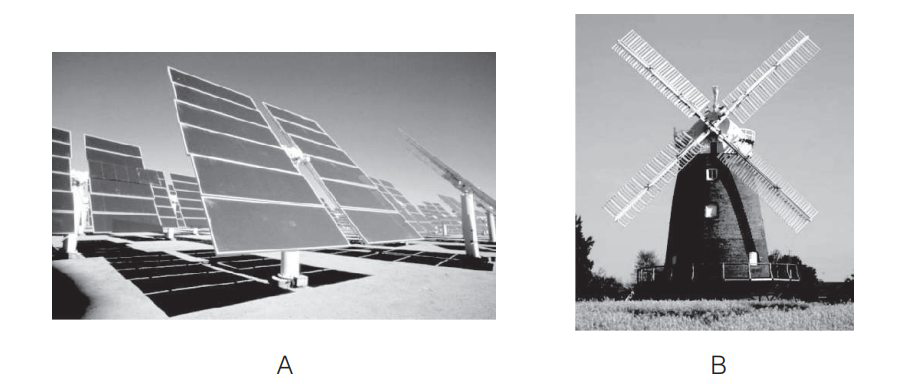Observe the figure A and B given below and answer the following questions
 (i) The power generation by the above two methods is non-polluting, True/False.
(i) The power generation by the above two methods is non-polluting, True/False.
(ii) List any two applications of solar energy
(iii) What is a photovoltaic cell?
(i) Figure $A$ is solar energy panel and figure $B$ is wind mill device. Both devices produce power without polluting the environment.
(ii) Solar lamp (lantern) (made up of a LED lamp, a photo-voltaic solar panel and rechargeable battery) and solar hot water system (geyser) are the two application of solar energy.
(iii) A solar cell is also called as photovoltaic cell. It is a form of photoelectric cell which converts the light energy into electrical energy by photovoltaic cell.
Write a short note on electronic waste. List the various sources of e-wastes and the problems associated with its disposal.
Solid waste can be biodegradable recyclable non-biodegradable, and can be categoriesed as municipal wastes (se-wage), industrial waste, hospitals and nursing wastes and electronic waste. Irrepairable computers, mobiles and other electronic goods are often known as 'e' waste or electronic waste.
Source of e-waste Majority of the developing countries like China, Pakistan and India import irrepairable electronic goods for their valuable metals like copper, nickel and gold.
Disposal of e-waste Such waste should be burried in landfills or incinerated. In developing countries, metal from e-waste is extracted manually. So, during working with e-waste, one can expose with toxic substances present in it, and may get affected by skin diseases in future. However, recycling is the only solution for the treatment of electronic waste.
What is organic farming? Discuss the benefits of organic farming as a viable practise in the context of developing nations like India.
Organic farming system primarily aims at sustainable production in an eco-friendly and pollution free environment. The land is cultivated by using techniques such as crop rotation, green manure, composting and biological pesticides alongwith beneficial microbes (biofertilisers) instead of chemical fertilisers and pesticides, etc.
Benefits of organic farming are
(i) Maintains long-term soil fertility.
(ii) Controls pests and diseases without harming the environment.
(iii) Ensures that water stays clean and safe.
(iv) Makes use of resources which the farmer already has, to make it economic.
(v) Helps produce nutritious food and high quality crops.
Organic farming in India
Using organic farming techniques makes much more sense for developing nations like India. As we know that modern, intensive agriculture makes the use of expensive chemical fertilisers and herbicides, which leach out from the soil and pollute rivers, lakes and water bodies and also damage the soil fertility in the long run.
Water logging and soil salinity are some of the problems that have come in the wake of the Green Revolution. Discuss their causes and adverse effects to the environment.
Water logging and soil salinity is caused by extensive irrigation without proper drainage of water.
Continuous presence of water draws salt to the surface of the soil, which gets deposited as a thin crust on the land surface or start collecting at the roots of the plants.
Adverse effects
(i) Increased salt content stunts the growth of crop plants.
(ii) Root cells saturated with saline water gets damaged.
(iii) Plants die.
(iv) Crop yield gets affected.
(v) Financial loss to the farmers.
Although properly managing the soil-water system can correct the salination and water logging, but the economic costs of this are very high.
What are multipurpose trees? Give the botanical and local names of any two multipurpose trees known to you and list their uses.
Multipurpose trees are those tree which on plantation fulfills a number of purpose, like shade, providing, soil improvement, provide wood, fruit and food etc. In other words, multipurpose trees serve a wide variety of function and services for human needs.
Neem ( Azardicta, indica) is known for its medicinal properties. Its fruit, leaves, wood and oil extracted from wood is used in most of the ayurvedic medicines. Its wood is pest resistant due to chemical azardiction. Another most important tree is coconut palm.
Its botanical name is Coccos nucifera and belongs to the family-Palmae, it serves a variety of function. As we get oil, wood and food fibre, from this plant. This plant has fibre, medicinal and commercial importance.
Some other multipurpose trees are Moringa oleifera and Gliricidia sepium, which is widely used for fences in central America and provide fire wood fooder and fix atmospheric $\mathrm{N}_2$. While M.oleifera is commonly used for animal forage and shade, its leaves are edible.